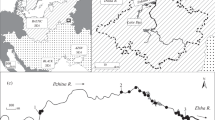Abstract
Twenty-three species of gastrotrichs were found in samples collected from 10 of the 19 water-courses examined. The richness of species and the faunistic composition are comparable with those in lentic sediments, even if specimens are more numerous in the latter. The Zambra riverlet in the Pisa Mountains is the richest (17 species) of the sampling biotopes. As in freshwater lentic environments, the presence of organic detritus causes an increase in both the number of specimens and species, whereas the fine fraction of the sediment (silt) leads to their sharp decrease. Lepidodermella squamata, Chaetonotus maximus and C. persetosus have proved to be ubiquitous species, while C. fluviatilis and Ichthydium squamigerum were only found in sand. Most species show a cuticular covering with a particular morphology which has probably favoured their moving from the surface of sediment towards interstitial spaces.
Similar content being viewed by others
References
Balsamo, M., 1977. Prime ricerche sui Gastrotrichi dulciacquicoli italiani. Atti Soc. tosc. Sci. nat. Mem., ser. B 84: 87–150.
Balsamo, M., 1980. Secondo contributo alla conoscenza dei Gastrotrichi delle acque dolci italiane. Atti Soc. tosc. Sci. nat. Mem., ser. B 87: 94–126.
Balsamo, M., 1990. Gastrotrichs from Lakes Bolsena, Chiusi and Monte pulciano (central Italy), with the description of four new species. Boll. Zool. 57: 165–178.
Balsamo, M. & E. Fregni, 1995. Gastrotrichs from interstitial freshwater, with a description of four new species. Hydrobiologia 302: 163–175.
Balsamo, M. & J. Kisielewski, 1986. Chaetonotus fluviatilis, a new fresh-water gastrotrich. Boll. Zool. 53: 111–114.
Balsamo, M. & M. A. Todaro, 1988. Life history traits of two chaetonotids (Gastrotricha) under different experimental conditions. Invertebr. Reprod. Dev. 14: 161–176.
Balsamo, M., E. Fregni & P. Tongiorgi, 1994. Marine and freshwater Gastrotricha from the Island of Montecristo (Tuscan Archipelago, Italy), with the description of new species. Boll. Zoll. 61: 217– 227.
Bertolani, R. & M. Balsamo, 1989. Tardigradi e Gastrotrichi del Trentino: il Lago di Tovel (Trento). Studi trent. Sci. nat., Acta biol. 65: 83–93.
Coninck, L. A. P., 1939. Scientific results of Prof. Dr. P. Van Oye's expedition in Iceland. Biol. Jahrb. 6: 219–223.
Evans, W. A., 1982. Abundance of micrometazoans in three sandy beaches in the island area of western Lake Erie. Ohio J. Sci. 82: 246–251.
Fenchel, T. M. & J.M. Riedl, 1970. The sulfide system: a new biotic community underneath the oxidized layer of marine sand bottom. Mar. Biol. 7: 255–263.
Forneris, L., 1966. Über zwei Chaetonotus Arten aus Hamburger Stadtgewässern (Gastrotricha). Abh. Verh. naturw. Ver. Hamburg, N.F. 10: 93–96.
Fregni, E., 1995. Gastrotrichi interstiziali marini e dulciacquicoli: indagini faunistiche, sistematiche e filogenetiche. PhD Thesis, Universitàdegli Studi di Modena, Italy, 257 pp.
Giere, O., 1993. Meiobenthology. Springer-Verlag, Berlin-Heidelberg New York, 328 pp.
Greiser, N. & A. Faubel, 1988. Biotic factors. In R. Higgins & H. Thiel (eds), Introduction to the Study of Meiofauna. Smithsonian Institution Press, Washington: 76–114.
d'Hondt, J. L., 1967. Documents sur les Gastrotriches dulcicoles des eaux franc¸aises. Ann. Limnol. 3: 381–397.
d'Hondt, J. L., 1971. Note sur quelques gastrotriches Chaetonotidae. Bull. Soc. zool. Fr. 96: 215–235.
Higgins, R. & H. Thiel, 1988. Introduction to the study ofmeiofauna. Smithsonian Institution Press, Washington, 488 pp.
Hummon, M. R., 1984. Reproduction and sexual development in a freshwater gastrotrich. 1. Oogenesis of parthenogenic eggs (Gastrotricha). Zoomorphology 104: 33–41.
Hummon, W. D., 1987. Meiobenthos of the Mississipi headwater. In R. Bertolani (ed.), Biology of Tardigrades. Selected Symposia and Monographs U.Z.I. 1, Mucchi, Modena, Italy: 125–140.
Kisielewska, G., 1981. Hermaphroditism of freshwater gastrotrichs in natural conditions. Bull. Acad. polon. Sci. biol. 29: 167–172.
Kisielewska, G. & J. Kisielewski, 1986. Freshwater Gastrotricha of Poland. II. Gastrotricha from the seaside lakes in the Slowinski National Park. Fragm. faun., Warszawa 30: 183–194.
Kisielewski, J., 1987. Two new interesting genera of Gastrotricha (Macrodasyida: Chaetonotida) from the Brazilian freshwater psammon. Hydrobiologia 153: 23–30.
Kisielewski, J., 1990. Origin and phylogenetic significance of freshwater psammic Gastrotricha. Stygologia 5: 87–92.
Kisielewski, J., 1991. Inland-water Gastrotricha from Brazil. Ann. Zool. 43: 1–168.
Levy, D. P., 1984a. Obligate post-parthenogenetic hermaphroditism and other evidence for sexuality in the life cycles of freshwater Gastrotricha. PhD Thesis, Rutgers University of New Jersey, New Brunswick, 274 pp.
Levy, D. P., 1984b. Equivalent life cycles with obligate post-parthenogenetic hermaphroditism in three genera of freshwater gastrotrichs. Am. Zool. 24: 146A (abstract).
Pennak, R. W., 1953. Freshwater invertebrates of the United States. Ronald Press, New York, 769 pp.
Pennak, R. W., 1988. Ecology of the freshwater meiofauna. In R. Higgins & H. Thiel (eds), Introduction to the Study of Meiofauna. Smithsonian Institution Press, Washington: 39–60.
Preobrajenskaia, E. N., 1926. Zur Verbreitung der Gastrotrichen in den Gewässern der Umgebung zu Kossino. Arb. biol. St. Kossino 4: 3–14.
Roszczak, R., 1969. Brzuchorzeski (Gastrotricha) srodkowej wielkopolski. Pr. Kom. biol. Pozn. TPN., Poznan 32: 1–92.
Ruttner-Kolisko, A., 1955. Rheomorpha neiswestnovae und Marinellina flagellata, zwei phylogenetisch interessante Wurmtypen aus dem Süsswasserpsammon. Österr. zool. Z. 6: 33–69.
Schwank, P., 1990. Gastrotricha. In A. Brauer (ed.), Süsswasserfauna von Mitteleuropas. Fischer Verlag, Stuttgart, Bd. 3/1, 252 pp.
Strayer, D., 1985. The benthic micrometazoans of Mirror Lake, New Hampshire. New Hampshire Arch. Hydrobiol. Suppl. 72: 287–426.
Weiss, M. J., 1984. How widespread is hermaphroditism among freshwater gastrotrichs? Am. Zool. 24: 146 (abstract).
Weiss, M. J. & D. P. Levy, 1980. Hermaphroditism and sperm diversity among freshwater Gastrotricha. Am. Zool. 20: 749 (abstract).
Author information
Authors and Affiliations
Rights and permissions
About this article
Cite this article
Fregni, E., Balsamo, M. & Tongiorgi, P. Interstitial gastrotrichs from lotic Italian fresh waters. Hydrobiologia 368, 175–187 (1998). https://doi.org/10.1023/A:1003250217483
Issue Date:
DOI: https://doi.org/10.1023/A:1003250217483




